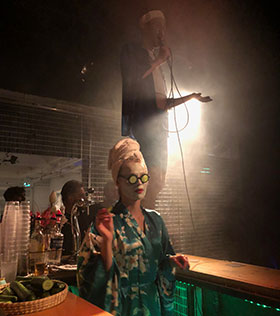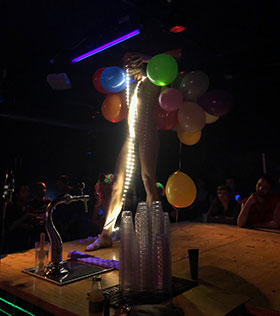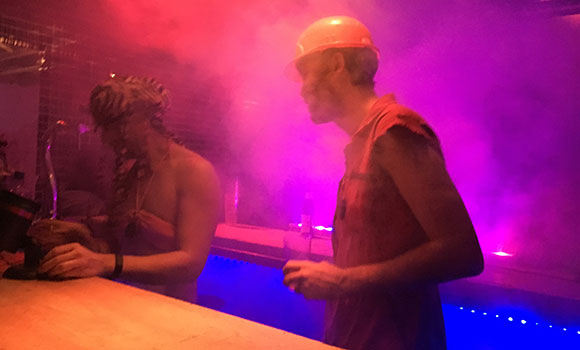‘What the f*ck?!-moments’ at the Performance Bar Rotterdam

The ‘Performance Bar’ exists in Rotterdam since April 2016, right from the moment the two founders Daniel and Florian decided to put a wooden lid on top of the open bar, consisting of a pile of crates made of steel wood and beads. Technically, we are talking about a bar that can transform into a stage. Literally, the barmen go out of the bar and performers claim the space, delivering acts that cover everything from lowbrow entertainment to the avant-gardist and profound.
Breaking some boundaries

For Daniel and Florian, the Performance Bar combines their biggest passions and strongest artistic beliefs:
The outbreak from the classical theatre scene, the engagement of the audience in a nonconventional, anti-elite way, and the use of art as a transformative tool for self-development. While not leaving the most essential out of sight: The Joy. Having a fun night out, partying together with people, all within the frame of contemporary art.
Right from the beginning, they developed a venturous counter course in how to run their bar. In a place with a musical organ and a bath tub inside, where the hosts organize ‘no pants parties’ or Monday morning raves, everything seems possible. Cross-dressed bar keepers blow vodka shots in your face, the hosts stop the music suddenly to invent stories with illogical plots or even ask their customers to join them on stage for a performance. Always on the mission to find interesting ways to play with social norms and boundaries, they are ready to challenge their visitors by breaking the status quo and throwing them into awkward situations.
The bubble of amazement
In the Performance Bar, guests may encounter all kinds of performance acts: Drag queens, drag kings, sword swallowers, dancing foam trees, a slutty male bikini lecturer, ‘Diversity Hitler’, or a performer disguised as a goat bleating and running through the bar on all fours. When I interviewed regular visitors, they labelled their encounters with likewise performances as ‘What the f*ck?!-moments’. Such disruptions with the ‘usual reality’ and expectancies is what causes a ‘bubble of amazement’, as Daniel calls it himself. By creating absurd and implausible situations, they can exaggerate awkwardness which is already present in our lives and can test individual limits of comfort and appropriateness.
On the surface, this all may seem like one big circus show, but underneath their concept shows quite impressive and profound layers. These mostly entertaining and humorous ways to create feelings of surprise, amazement and awkwardness, create a strong temporary social bond of the audience (Kotsko 2010a) and beyond that can stimulate so called transformative learning experiences and open-minded cognition, particularly for regular visitors (Kegan 2018).
Messing with your mind

We all have our own ideas about how the world runs and present ourselves to other people based on our life experiences and previous interactions with others (Sökefeld 1999).
Depending on what we perceive as ‘normal’, we comply to roles and status and agree on social norms, codes and boundaries (Schultz et al. 2007).
In the Performance Bar, artists break these conceptions of normality by introducing personal or societal issues in a most unconventional and abstract form that extracts strong emotions in the audience and provokes their mindset and world view. This play with social norms and boundaries connects to the idea of postmodernity that there is no ultimate truth to be found, and that what we consider as ‘reality’ is a product of social construction (Águila et al. 2008). Hence, everything becomes relative, subjective and context depended (e.g. cultural heritage, gender, age, sexuality), as social constructs are ever-changing and constantly shifting in the flux of time and situational contexts.
In the Performance Bar differing values, norms and worldviews collide and challenge dualistic views of two opposing principles (e.g. good and evil, appropriate and inappropriate). In the same way heterodox art brings different lessons to different individuals, each visitor has its own way to make sense of a performance and integrates it accordingly into her/his cognitive structure (Piaget 2013).
Embrace the awkwardness!
According to psychologist Piaget we construct new knowledge by resolving conflicts. When confronted with novel and unusual, perhaps disturbing happenings, each audience member uses different coping strategies in how to deal with the disruption of normality. Whether an individual creates new knowledge and arrives at a resolution, depends on her/his ability to process conflicting or contradicting information.
Supposedly, there are three forms of coping. The first is direct assimilation, which involves fitting new information into existing schemes (what was already known). Then there is knowledge building, which considers new information as something problematic that needs to be explained and accommodated it into a new mental structure (Piaget 2013). However, there is also the possibility that the conflict remains unsolved and the learning stream runs dry.
The third option is most likely to happen to first time visitors of the Performance Bar who get into the ‘fight or flight’ mode, resulting in either leaving the bar immediately or starting to ‘sabotage’ the play, by shouting or intervening. Depending on how visitors perceive the disruptive awkward moment it may loosen their boundaries of what they constructed as normal or contrariwise confirm the usefulness of the social norm and boundary. In the former case, a transformation is taking place, and the former boundaries are crossed, the social norms are widening, which some scholars ascribed to cognitive flexibility, and tolerance for ambiguity.
Are you telling me I could be wrong?

The possibility to arrive at a resolution for the conflict depends on the awareness and the monitoring of one’s own biases and mental pitfalls.
Such an attitude of open-mindedness can be trained by exposing oneself to a variety of ideas and worldviews (Riggs 2010). Closed-mindedness can be the result of taking one’s assumptions to be obvious and universal, hence incontrovertible. To discover that those assumptions are not shared by people across different cultures, time and place can help one see that one’s assumptions are controvertible after all.
Knowledge can be seen as always transitory and constantly converting, and the possibility of being wrong can never be entirely erased. This makes open-mindedness an optimal attitude when striving for cognitive excellence and intellectual humility but can also be considered an important civic virtue that can foster tolerance in contemporary pluralistic societies (Riggs 2010).
Open-mindedness is a skill that is required for, but also trained in the Performance Bar. For building resilient democratic and civic values, we need a balance between convictions — our firmly held beliefs — and open-mindedness, the acknowledgement that our ignorance can be invisible and the things we believe might in fact be wrong. By listening to opposing views and learning from the experience of others we can open ourselves to a broad analysis of the causes of and solutions to social and personal problems.
And one last thing to keep in mind: ‘There is a difference between an open mind and an empty head’ (Dey 1999: 255).
References
Águila, C., Sicilia-Camacho, Á., Rojas Tejada, A. J., Delgado-Noguera, M. A., & Gard, M. (2008). Postmodern values and leisure in young Spanish university students: an exploratory study. Leisure Sciences, 30 (4), 275-292
Dey, I. (1999). Grounding grounded theory. San Diegeo: Academic Press.
Kegan, R. (2018). What ‘form’ transforms?: A constructive-developmental approach to transformative learning. In Illeris, K. (ed.), Contemporary theories of learning (pp. 29-45). Routledge.
Kotsko, A. (2010). Awkwardness. John Hunt Publishing.
Piaget, J. (2013). Play, dreams and imitation in childhood. Routledge.
Riggs, W. (2010). OpenMindedness. Metaphilosophy, 41 (12), 172-188.
Schultz, P. W., Nolan, J. M., Cialdini, R. B., Goldstein, N. J., & Griskevicius, V. (2007). The constructive, destructive, and reconstructive power of social norms. Psychological science, 18 (5), 429-434.
Sökefeld, M. (1999). Debating self, identity, and culture in anthropology. Current anthropology, 40 (4), 417-448.
Meer informatie over het onderzoek?

Reageer (je reactie verschijnt na goedkeuring, vanwege spam)